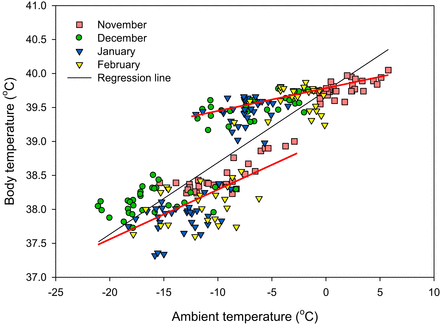The Qinghai-Tibetan Plateau, with low precipitation, low oxygen partial pressure, and temperatures routinely dropping below -30 °C in winter, presents several physiological challenges to its fauna. Yet it is home to many endemic mammalian species, including the plateau pika (Ochotona curzoniae). How these small animals that are incapable of hibernation survive the winter is an enigma. Measurements of daily energy expenditure (DEE) using the doubly labeled water method show that pikas suppress their DEE during winter. At the same body weight, pikas in winter expend 29.7% less than in summer, despite ambient temperatures being approximately 25 °C lower. Combined with resting metabolic rates (RMRs), this gives them an exceptionally low metabolic scope in winter (DEE/RMRt = 1.60 ± 0.30; RMRt is resting metabolic rate at thermoneutrality). Using implanted body temperature loggers and filming in the wild, we show that this is achieved by reducing body temperature and physical activity. Thyroid hormone (T3 and T4) measurements indicate this metabolic suppression is probably mediated via the thyroid axis. Winter activity was lower at sites where domestic yak (Bos grunniens) densities were higher. Pikas supplement their food intake at these sites by eating yak feces, demonstrated by direct observation, identification of yak DNA in pika stomach contents, and greater convergence in the yak/pika microbiotas in winter. This interspecific coprophagy allows pikas to thrive where yak are abundant and partially explains why pika densities are higher where domestic yak, their supposed direct competitors for food, are more abundant.

The average night-and daytime body temperatures averaged across diurnal and nocturnal hours across all six implanted individuals plotted against the simultaneous ambient temperature. Lines show the fitted linear regressions. Red lines are linear regressions for daytime and nighttime temperatures, and black line is overall regression through all the data. Pikas lowered their body temperatures as it got colder and did this more so at night than in the day.
This result was published in Frontiers in Proceedings of the National Academy of Sciences with the title of “Surviving winter on the Qinghai-Tibetan Plateau: Pikas suppress energy demands and exploit yak feces to survive winter”.
The link below will guide you to the reading:
